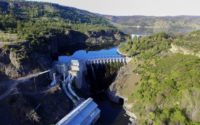Flood Control
Lake Houston Dam Improvements Scaled Back Due to Budget

Lake Houston's spillway dam.
Photo courtesy of the city of Houston
An effort to bolster flood control in northeast Houston through improvements to the Lake Houston dam have been scaled back due to financial constraints on the project. Houston officials say that the length of proposed floodgates will need to be reduced by half to meet the project’s budget.
The $48 million project is being funded by a hazard mitigation grant from the Federal Emergency Management Agency (FEMA) the city was awarded in 2019. According to the city, the project will help protect about 35,000 residents and 5,000 structures from flooding events.
According to the city, the FEMA grant provides $4.3 million for the initial planning and design phase of the project and provided $42.7 million for construction. The remaining funds will be provided by the city of Houston, which owns Lake Houston, and the Harris County Flood Control District.
In a statement, Houston Mayor Pro-Tem Dave Martin said he is “committed to providing the community with the best project that can move the highest volume of water at a safe speed so not to negatively impact downstream neighbors.”
City officials initially planned to start the projected 18-month-long construction phase later this year, but that will likely push into 2023.
Initial plans for improvements to the Lake Houston dam called for 1,000 ft of new floodgates to be construction on the existing structure, an amount that would have increased water release rate to 40,000 cubic ft per second. The improvements would have drastically reduced the amount of time the lake levels could be lowered to handle expected flood conditions in the watershed.
Kansas-based Black & Veatch was tapped as the design contractor for the project in 2020 found that the cost of the proposed gates, when factored in with the necessary reinforcement work to the existing structure exceeded the project’s budget.
Stephen Costello, chief recovery officer for the city of Houston, says the design of the project has been temporarily put on hold as the city evaluates the cost-benefit analysis. The city hopes to complete the design that integrates the new criteria and submit the proposal to FEMA by the end of the year. The federal agency will then need to evaluate the proposal before releasing funds for construction.
Lake Houston's dam consists of a conventional reinforced concrete slab and a 3,160-ft-long spillway flanked by two compacted earth-fill embankments. The reservoir is fed by a confluence of the West and East Forks of the San Jacinto River. The dam’s four existing gates have a discharge capacity of 10,000 cubic ft per second. The Lake Conroe dam immediately upstream has a capacity of 150,000 cubic ft per second.
According to a Freese & Nichols study conducted in 2018, additional gates on the Lake Houston dam would allow better synchronization of water release between the two dams, thus reducing flood risk. Additionally, Lake Houston is a water supply source for the city of Houston requiring flood mitigation efforts match with the city’s freshwater needs.
“So with the new gates, we could minimize the time between a flooding event occurring so that we don't have to unnecessarily lower the lake levels in advance,” Costello explains.
During Hurricane Harvey in 2017, the lake was overwhelmed and water discharge rates at the dam reached 425,000 cubic ft per second, according to the Freese & Nichols analysis. Lake Conroe water discharge rates during that period were less than a fifth of that amount.
In addition to the dam improvement project, more than $222 million of dredging projects are underway on the San Jacinto River and Lake Houston. These operations are aimed at providing flood mitigation by removing sediment deposits and increasing the capacity of the lake. In total, the city plans to remove more than 4 million cubic yards of material from the waterway – a significant amount of which was deposited during the Hurricane Harvey.




